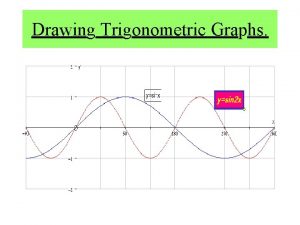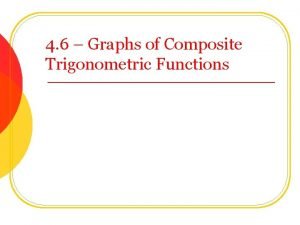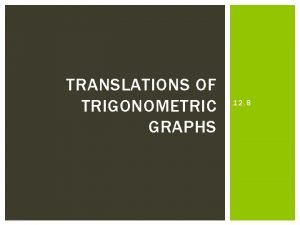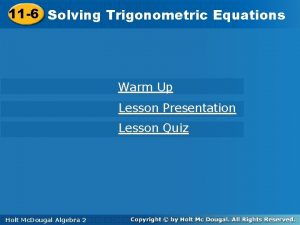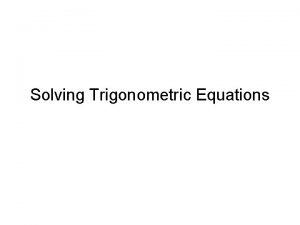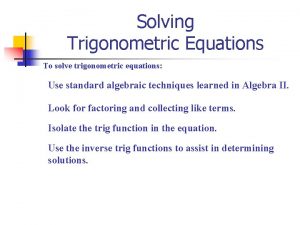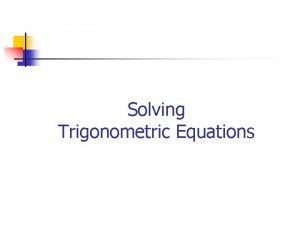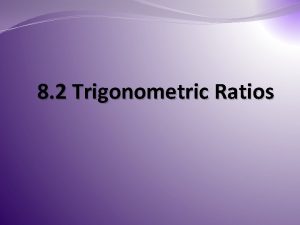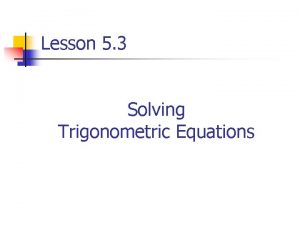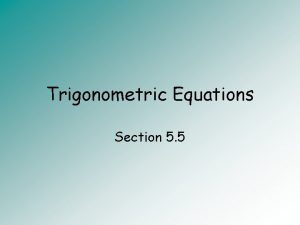TRIGONOMETRIC EQUATIONS Firstly recall the graphs of y









- Slides: 9

TRIGONOMETRIC EQUATIONS

Firstly recall the graphs of y = sin x, y = cos x and y = tan x. Note: sin x is positive y = sin x for 0º < x < 180º, and negative for 180º < x < 360º. y = cos x y = tan x Note: cos x is positive for 0º ≤ x < 90º, and for 270º < x ≤ 360º and negative for 90º < x < 270º. Note: tan x is positive for 0° < x < 90º, and for 180º < x < 270º and negative for 90º < x < 180º. and for 270º < x < 360º.

We can summarise the information in the following diagram: 90º sin +ve cos –ve cos +ve tan –ve tan +ve º º 180 0 , 360º sin –ve cos +ve tan –ve 270º This can be simplified to show just the positive ratios: 90º S A sin +ve all +ve or just: 180º 0º, 360º T C tan +ve cos +ve 270º

The positive ratio diagram can be used to solve trigonometric equations: Example 1: Solve cos x = 0. 5; 0º ≤ x < 360º Using: S A T C We can see that the cosine of an angle is positive in the two quadrants on the right, i. e. the 1 st and 4 th quadrants. α = cos– 1 0. 5= 60º Hence the solutions in the given range are: x = 60°, 360 – 60° so x = 60º, 300º

Example 2: Solve sin x = – 0. 5; – 360º < x ≤ 360º The sine of an angle is negative in the 3 rd and 4 th quadrants. α = sin– 1 0. 5= 30º N. B. The negative is ignored to find the acute angle. Hence the solutions in the given range are: x = – 150°, – 30°, 210°, 330° In problems where the angle is not simply x, the given range will need to be adjusted.

Example 3: Solve 3 + 5 tan 2 x = 0; 0º ≤ x ≤ 360º. Firstly we need to make tan 2 x the subject of the equation: 3 tan 2 x =– 5 The tangent of an angle is negative in the 2 nd and 4 th quadrants. = 30. 96° The range must be adjusted for the angle 2 x. i. e. 0° ≤ 2 x ≤ 720°. Hence: 2 x = 149. 04°, 329. 04°, 509. 04°, 689. 04°. x = 74. 5°, 164. 5°, 254. 5°, 344. 5°.

Example 4: Solve 2 sin (4 x + 90º) – 1 = 0; 0 < x < 90º sin (4 x + 90º) The sine of an angle is positive in the 1 st and 2 nd quadrants. = 30º The range must be adjusted for the angle 4 x + 90º. i. e. 0º < 4 x < 360º 90º < 4 x + 90º < 450º 4 x + 90º = 150°, 390° 4 x = 60º, 300º x = 15º, 75º

Example 5: Solve 6 sin 2 x + sin x – 1 = 0; 0º ≤ x < 360º A quadratic equation! It may help to abbreviate sin x with s: i. e. 6 s 2 + s – 1 = 0 Factorising this: (3 s – 1)(2 s + 1)= 0 α = 19. 47º º α = 30 So, x = 19. 5°, 160. 5°, 210°, 330°. (To nearest 0. 1º. )

Summary of key points: To solve a Trigonometric Equation: • Re-arrange the equation to make sin, cos or tan of some angle the subject. • Locate the quadrants in which the ratio is positive, or negative as required. Using: S A T C • Adjust the range for the given angle. • Read off all the solutions within the range.
 Firstly define
Firstly define Drawing trigonometric graphs
Drawing trigonometric graphs Lesson 9 awkward who chose the number 360
Lesson 9 awkward who chose the number 360 Graphs of composite trigonometric functions
Graphs of composite trigonometric functions 12-8 skills practice translations of trigonometric graphs
12-8 skills practice translations of trigonometric graphs Graphs that compare distance and time are called
Graphs that compare distance and time are called Graphs that enlighten and graphs that deceive
Graphs that enlighten and graphs that deceive Which two graphs are graphs of polynomial functions?
Which two graphs are graphs of polynomial functions? Good state graphs and bad state graphs
Good state graphs and bad state graphs Solving linear trigonometric equations
Solving linear trigonometric equations

